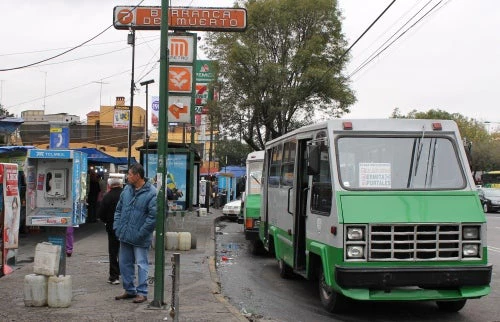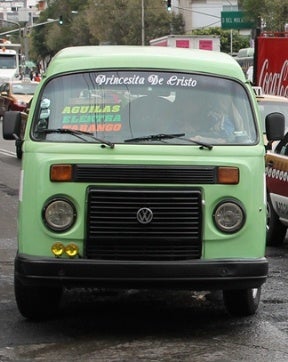
Safe, Clean, Affordable Transport is the motto of the World Bank’s Transport Sector. Evidence from several analyses for urban transport systems suggests that improving the transport system
- reduces passenger travel times,
- reduces GHG emissions due to transport,
- reduces vehicle operating costs for the transport system, and
- reduces transport-related road accidents (injuries and fatalities).
Bogota and Mexico City are two examples of cities that have, year after year, received global recognition for their advances towards better public transport, such as Mexico City’s 2013 ITDP Sustainable Transport Award and Bogotá’s 2013 C40 World City Leadership award for Urban Transportation.
So when I became acquainted with expressions of nostalgia for the traditional bus system in Bogota and Mexico City*, I couldn’t help feeling surprised: No matter how big and beneficial the positive changes in their public transport systems are, citizens both in Bogota and Mexico also experience nostalgia for some aspects of their traditional but disappearing bus systems.
So I thought, regardless of their flaws, traditional bus systems have become as iconic for locals as the red double decker buses for Londoners. So what is it that we will miss from traditional bus systems? And, why? As a Bogotano who considers Mexico City a second home, here is my answer to the question:
The traditional buses have operational features which are more convenient than those in modern systems:
- allow hailing them at any point, and requesting a stop anywhere (especially convenient on early mornings and late nights, since sidewalks in many areas of both cities are not in the best condition);
- are usually less crowded than the ones in modern systems (due to uncontrolled oversupply), meaning that many users are even able to sleep comfortably while commuting;
- have very high frequencies (same reason than before); and
- allow paying by cash, and negotiating the fare if there is a good reason to do so (time of the day, distance travelled, travelling group).
Traditional bus systems also have nicknames: “la buseta”, “el ejecutivo”, “el cheto” (Bogota), and “la combi”, “el pesero” or “la micro” (Mexico). Other bus features such as painting, decals, religious imagery, interior and exterior accessories, furnishing and lighting have all given very particular looks to our traditional bus systems.
In some way, drivers and users have appropriated a globally available service and customized it to reflect the particular traits of their urban identity and folklore.
Efficiency, yes. But personality?

The bus drivers are the soul of the current system and are responsible for creating much of the multisensory experience which is associated with bus journeys in Mexico City or Bogota.
They have a diverse set of driving skills which allows them to perform money and distance calculations for distance-based fares, and are experienced in overtaking traffic starting and stopping at neck-breaking speeds**.
Drivers in traditional systems are also capable of expressing their personalities through so many ways: upon stepping into the bus, drivers will always reply to your salutation, either with a friendly hello, or an urgent request for you to give room for other entering passengers.
Many users also cherish the fact that most drivers are willing to give detailed explanations of their routes, timing and traffic forecasts, announce stops, and even cater special stopping requests. Drivers play their favorite tunes or news radio station, and are also autonomous to offer discounted fares.
They are also willing to let into the bus informal food vendors, singers and other street artists in exchange for any small retribution in kind.
This wide spectrum of expressions of personality from “drivers” contrasts tremendously with modern “operators”, which sit under a sign that reads “please do not talk to operator” and are trained to drive quietly, stop at designated bus stops, deny access to passengers without enough credit on their prepaid cards and avoid customizing the look of their units.
A smart marketing strategy
Traditional bus systems, with all its not-so-nice things (slow, old, inefficient, unsafe), have nevertheless built a brand for public transport which is integrated into the collective perception of our cities’ identities.
This reflection led me to think on what is still missing in our modern bus systems: a successful and comprehensive branding strategy! This, to my experience, is sometimes overlooked or overly simplified by the transport planning experts.
In other words, cities need to raise a new brand for their new buses and market it: efficiency from a transport planning perspective is not appealing enough for common users. And, since transport is considered a “public service”, participatory mechanisms by which users can take part in the shaping and branding of their system is paramount.
Safe, Sustainable and Affordable bus systems should be proud icons of every city. And as any other business, bus systems can benefit hugely from clever, fresh and comprehensive marketing strategies. Or just look at examples from the car industry, and their unashamed use of sex, humor and thrills to sell metal caskets on four wheels stuck in traffic.
*: I came across this interesting journalist portrait from the traditional bus system in Mexico while reading the Mexican “Chilango” magazine on a waiting lounge at a Mexican Airport during a Bank mission. Later, the article won the 2013 ITDP Sustainable Transport Award in the category of journalism.
**: Although tongue-in-cheek comments are abundant in this paragraph, on a more serious note it should be said that a high rate of traffic accidents also take place many times because of hazardous driving and stopping maneuvers, speeding (due to penny wars) and lack of training and maintenance.


Join the Conversation